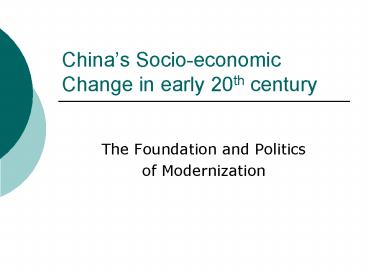Chinas Socioeconomic Change in early 20th century - PowerPoint PPT Presentation
1 / 8
Title:
Chinas Socioeconomic Change in early 20th century
Description:
Petty bourgeois: shopkeepers, independent craftsmen ... Chinese national bourgeois, and their duel characteristics in relation to foreign powers, ... – PowerPoint PPT presentation
Number of Views:43
Avg rating:3.0/5.0
Title: Chinas Socioeconomic Change in early 20th century
1
Chinas Socio-economic Change in early 20th
century
- The Foundation and Politics
- of Modernization
2
The Capitalist Sproutsthe CCP Historical
Reconstruction
- Around 1600, Chinas industrial and commercial
development became so comprehensive that China
would have evolved into the capitalist stage, had
the western powers had not imposed their will and
system onto China. True or False? - A concentrated work force in urban area, and a
sophisticated monetary system can be traced back
at least to the Song Dynasty - The missing of a relatively independent bourgeois
class imperial govt owned the big factories the
cultural bias against mercantile enterprises 95
of the economy based on small-scale subsistent
farming limited domestic market, in spite of
impressive urban islands
3
Tenancy Peasant Immiseration
- What was the cause of stagnant industrial
development in 1600-1900? Both CCP GMD blamed
on backward agriculture system land to the
tillers to create viable market, - High tenancy and its problem Is tenancy a form
of feudalism? - 85-90 tenancy in the south profitability
transportation facility. - The traditional role of gentry class leadership
in the village, informal government, - The harsher social condition and violence in
countryside since late 19th century,
4
The solutions land reform or revolution?
- Land reform as a part of Sun Yet-sens policy to
improve peoples livelihood and Chinas economy
Land belong to the tillers. But the GMD never
implemented a reform program until 1960s in
Taiwan - the CCPs radical land revolution program
confiscation of land from landlords,
redistribution to the peasants - Was the land-holding pattern the ultimate problem
of Chinas modernization? - The land-holding pattern and the dynastic cycle
farmers down-ward mobility due to venerability
of small-farming, inheritance tradition, and the
market elements since the Han Dynasty.
5
The CCPs Land Program its Problems
- The political utility of CCP land policy peasant
mobilization for class struggle, - Categories of CCP classification
- Landless farm hands
- Poor peasants lower-middle peasants
- Middle peasants
- Rich peasants
- Landlords
- The rich peasant problem allies or enemies?
- The criteria regional variation
- The policy shift during the Anti-Japanese war
- The resumption of radical approach in the civil
war and after 1949 - What was the result of the CCPs program?
- One million landlords killed, 60 land changed
hands - A quick lesson small farmers started to lose
land - The solution collectivization nationalization
6
Problems in Chinas Industrialization
- The Confucian tradition of promoting agriculture,
disparaging commerce - the fate of Chinas first railway
- the fate of Yan Fu Chinese overseas students
Confucianism as the force of inertia? - Carlo Cipolla Industrial Rev. is above all a
socio-cultural fact - The issue of insufficient market needs and the
theory of self-exploitation - Max Weber rationalization trend and two
irrational modes tradition and charisma, - Small farmers work hard, but under market value
in a closed economy, - 1842-1943 the treaty system put China in a
position as western powers dumping ground, the
imbalance of export-import racial, - Taiwans miracle 1960s export boom,
- Chinas recent miracle an export-dependent
economy
7
Western impact and solutions to the industrial
problems
- The limits and failure of the Self-Strengthening
movement - The Sun generation as products of the new school
system - The attraction of the German-Japanese model
state-sponsored industrial development, and its
problems - Civil war, disunity, and weak state power,
- The Nanjing Decade 1927-37,
8
The CCPs Conception of Chinese Urban Class
Structure
- The proletarians (working class the yellow
trade union) - Petty bourgeois shopkeepers, independent
craftsmen - Chinese national bourgeois, and their duel
characteristics in relation to foreign powers, - Compradors Chinese businessmen working for
foreign firms, - Imperialists (foreign businessmen)































